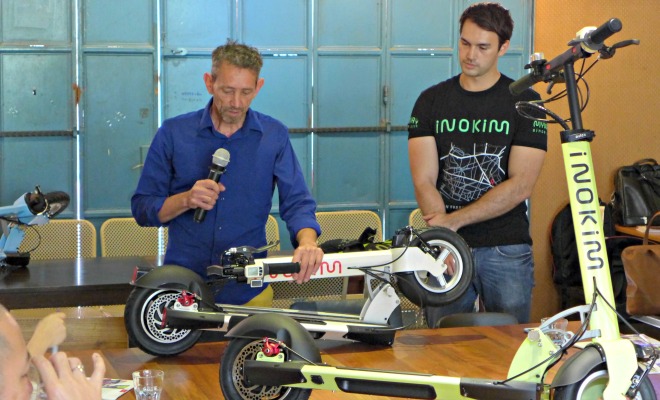
Insights + interviews
In Conversation With Nimrod Sapir
We interview 51-year-old Israeli entrepreneur and designer, Nimrod Riccardo Sapir (NS) on how his new product, the INOKIM Quick 2 Electric Scooter can be a fun product for active agers.
AA: What was your motivation and inspiration behind the development of the INOKIM electric scooter?
NS: My motivation? I’ve always been active and I think I’m a creative person who thinks alternatively. When I need to go somewhere, I’d always think about the best way to, and not just turn to the car. I lived in New York for three months so I was on roller blades, and while I was living in Australia I rode bicycles to work. Everywhere I go, I’d look for something else more efficient to ride on. As a designer, I have a lot of experience on how to bring ideas and things to life. It’s a process you need to know how to do which I managed to. It didn’t come in a day of course. It happened to be that I was unemployed in 2008 and had some time to think. Then I had a great idea on how to fold an electric scooter and so it started from there. But as I was working by myself and didn’t have a company behind me nor any money, I decided to drop the idea, but it all came to pass and I eventually introduced the idea of a simple, lightweight and intuitive multi-foldable scooter to people and started a company, and this is how it came to be.
AA: Would you say the INOKIM electric scooter is suitable for all ages? Is it user-friendly and easy to control especially for older users that are in the 45 to 65 year old range?
NS: It is absolutely easy. My father is 83 years old, and he rides it easily. And it’s meant to be easy because I wanted people to not have to learn how to ride it. So for anyone that has ever used a bike, it’s even easier for him or her to just step on the scooter, press the button and go. There’s really nothing more to it and nobody has failed at it so far.
AA: As an active ager yourself, how would you encourage other active agers to pick up scooter riding as a hobby?
NS: Well for one, the scooter isn’t heavy and is very compact when you fold it. You can always keep it in your car trunk or in the house. Especially if it’s in your trunk, it’s convenient whenever you go to a park, or a place… Well maybe now in Singapore you can’t ride it in parks, but anywhere else that you can, it’s in the car anyway. Let’s say you’ve got your car in the parking lot but now you want to go 500 metres away from the car, or two kilometres… When it’s in the trunk, you can just take it out and use it. The fact that it’s light and foldable and is always with you in the car, makes it very convenient and easy to use.
AA: Are there any advantages that riding an electric scooter riding has over cycling?
NS: Advantages, well absolutely! You basically don’t perspire, unlike bicycles where you have to pedal. I do encourage cycling but if you don’t want to break a sweat or if you have foot problems, surgeries or hip replacements, which I’ve had myself actually, the electric scooter is great. People with difficulty cycling or walking but yet still want to get outside to move and feel the air and breeze, can simply press the accelerator button on the electric scooter and move. I think it’s a good solution for them.
AA: Given that the Land Transport Authority (LTA) in Singapore does not permit the use of electric scooters on public roads, pavements and parks, how would you convince active agers to purchase one?
NS: You know, that’s the toughest question. What happens is that technology usually comes first, and then the laws and regulations come following after. I think you can’t just disallow it if there’s a whole movement of people who want to use some sort of technology; the law has to be flexible and adjust itself to the needs of the audience and the public in some way. I mean the electric scooter really isn’t just meant for using within your private garden, it’s definitely a tool for fun, transport, reducing car usage, and many other positive things. But of course it’s also a vehicle, so it needs to be in some way, legalised or controlled. I mean, you wouldn’t want a 10 year old kid riding on this thing, so there should be some rules to ensure the use of protection gear or having speed limits, power limits or age limits. Still, something has to connect and make it possible for people to use these kind of things. People are using bicycles and electric bicycles, so what’s the difference?
AA: Given your experience in alternative urban transportation, what are some good tips you have for new users?
NS: First of all, you’ll need to know the rules, and obey them. Because I don’t think we would like others to have the impression that we’re law-breakers, right? We don’t want people to think that “Oh, these riders are horrible and run people over” and stuff like that. So do learn about the local rules and whether it’s possible to ride on roads, pavements, or on bicycle lanes and follow them. Secondly, you have to understand that the scooter’s maximum speed is 25 kilometres per hour, which is a relatively fast speed that people do not expect. So when you’re approaching people from behind, or other bicycle riders, you’re very silent and others may not be aware of you. He or she might turn around all of a sudden and you might crash into that person. So be careful when you’re approaching other people, slow down or maybe ring the bell to notify them that you’re behind them. The wheels are also relatively small so if you hit a 17 centimetres pavement, you will fall or even damage the scooter. If you go up a small ramp and the roads slope downwards, be careful not to brake too hard as it can flip you over. The scooter’s got a very nice handling but it’s still good to practice controlling it a little bit in your own private space.
AA: Besides your passion and interest in developing the INOKIM electric scooter, what other hobbies or leisurely activities do you engage in during your free time to stay active?
NS: Personally, I cycle and hang glide. I also do a bit of windsurfing sometimes. I’ve done hang gliding for 20 years and windsurfing for about 40 years.









